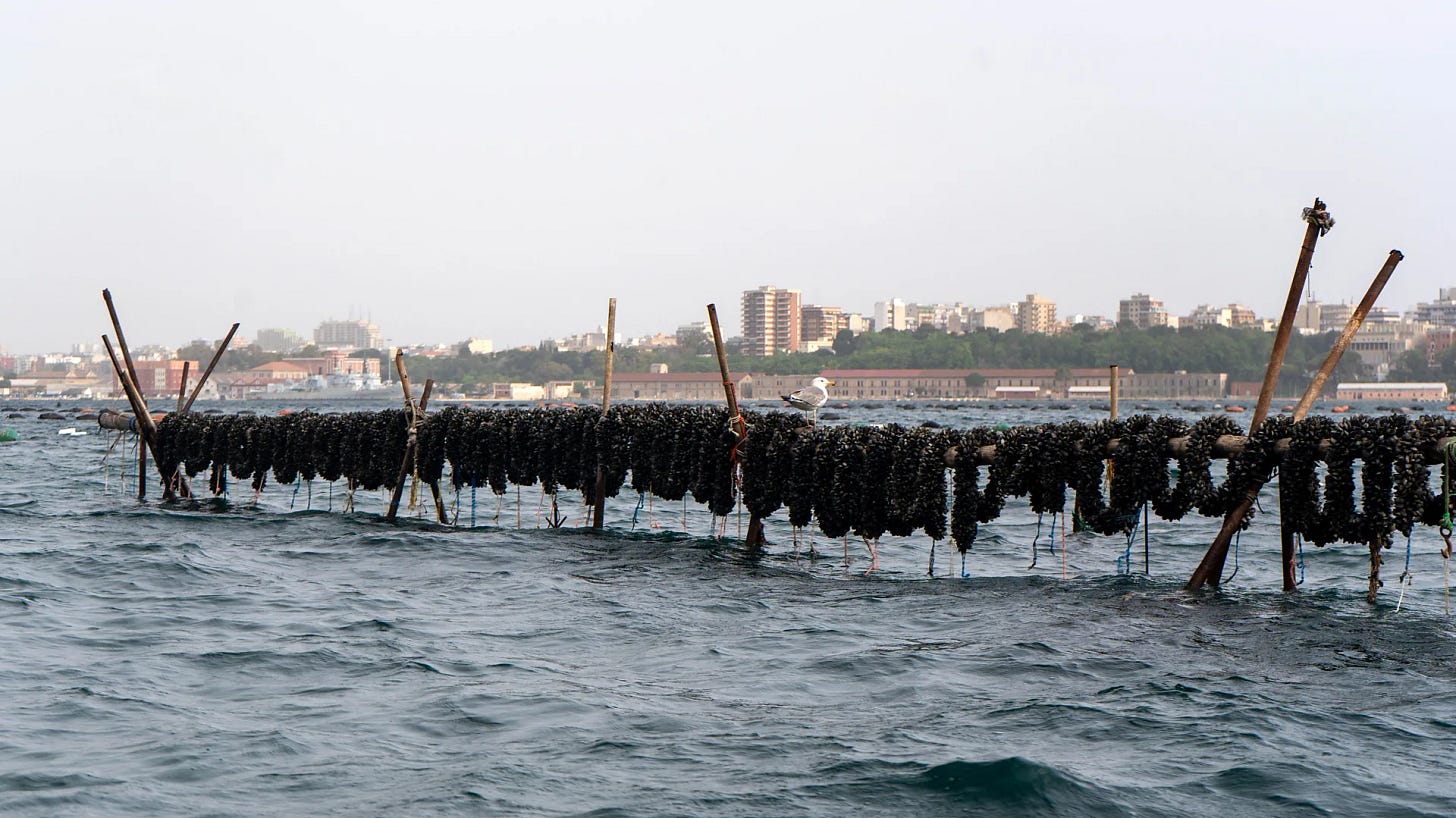In today’s letter: the termination of the US Women, Peace & Security program, protests against women’s rights in Bangladesh, malnutrition rates in children in Gaza, an environmental comeback for mussel farming in Italy, women’s AI voices, the Egyptian women’s football team, the Guerrilla Girls are celebrating an anniversary, and much more.
Good morning from my handlebars and headspace,
I’m writing to you in that golden sliver of the day—post-spin and eyebrow appointment, and just before I log on for work. This morning’s hour-long bike ride gave me the perfect excuse to carve out time for one of the books I’m currently juggling, and I’m glad I did.
This weekend brings two book club discussions, which means I’m in my usual last-minute sprint to finish both titles. (It’s a pattern I’ve accepted—I always pull it off, which is probably why I never learn.) First up: The Story of Jane: The Legendary Underground Feminist Abortion Service by Laura Kaplan. It traces the formation and impact of the Chicago-based Abortion Counseling Service—better known as Jane—and how the women involved evolved from counselors to providers in the fight for reproductive justice. While I’m not in love with the writing, the story itself is powerful, and I’m learning a lot about grassroots organizing, decision-making under pressure, and collective care.
Last night, on a whim, I started the audiobook of The Women of NOW: How Feminists Built an Organization That Transformed America by Katherine Turk. I’m thinking it will add more depth to Friday’s discussion and offer context around feminist organizing that I can’t help but connect to the Jane narrative.
The second book club read is Another World Is Possible: Lessons for America from Around the Globe by Natasha Hakimi Zapata. This one is energizing in a different way—it profiles nine progressive policies from around the world that are working beautifully and that the U.S. could learn from. On the bike this morning, I dove into the chapter on Finland’s public education system, which seems to satisfy everyone it touches—students, teachers, families, and the country at large. Other chapters explore Singapore’s affordable housing model and the evolution of the U.K.’s National Health Service. It’s the kind of book that shifts the narrative from despair to imagination—and that’s a powerful thing.
So that’s what I’m turning the pages of this week. How about you—what’s on your nightstand, in your earbuds, or weighing on your mind?
Last week, U.S. Secretary of Defense Pete Hegseth announced the termination of the Women, Peace & Security (WPS) program, wrongly attributing it to the Biden administration and dismissing it as a “woke” distraction. In fact, the WPS Act was signed into law by President Trump in 2017 with bipartisan support, building on a broader international agenda first codified by UN Security Council Resolution 1325. WPS promotes the inclusion of women in peace negotiations, conflict prevention, military operations, and post-conflict recovery. Its goals are rooted not only in values of equity but in data: peace agreements are significantly more durable and effective when women participate. The program has become a cornerstone of modern security and diplomacy strategy, embraced by allies and integrated into U.S. military planning and training.
Hegseth wrote, “WPS is a UNITED NATIONS program pushed by feminists and left-wing activists.”
Senator Jeanne Shaheen (D-NH), a key architect of the legislation, called the Secretary’s decision “unlawful and dangerously short-sighted.” Experts warn that dismantling WPS could erode U.S. credibility abroad, weaken our ability to engage local communities in conflict zones, and hamper efforts to build a diverse and capable military force.
I studied WPS extensively during my Master’s and continue to believe it is one of the most compelling, evidence-based strands of global development and peacebuilding that we have. Its elimination isn’t just bureaucratic—it reflects a deeper misunderstanding of what makes peace sustainable and security meaningful in the 21st century.
In Dhaka, Bangladesh, more than 20,000 supporters of the Islamist group Hefazat-e-Islam rallied to protest proposed legal reforms aimed at granting Bangladeshi women, particularly Muslims, equal rights to property. The group condemned the recommendations as incompatible with Sharia law and accused the interim government, led by Nobel laureate Muhammad Yunus, of undermining religious values, even demanding the reforms commission be disbanded and its members punished. With banners warning against “Western laws” and a threat of nationwide rallies later this month, the protest marks a flashpoint in a tense political climate shaped by the recent ousting of former Prime Minister Sheikh Hasina, now in exile, and a growing assertiveness among Islamist factions.
More than three years since Afghan women first chanted “Bread, Work, Freedom” in the streets, their call rings louder than ever. Under Taliban rule, women have been barred from most paid professions, harassed for working without a male guardian, and cut off from running even modest beauty salons—once a rare source of income for many. With female labor participation now estimated at just 5 percent, the country’s economic crisis has deepened, yet Afghan women continue to resist, launching home-based microenterprises, running online businesses, and demanding that the global community recognize gender apartheid as a crime under international law.
In 2024, Egypt’s Women’s Premier League made its national television debut—a quiet revolution for a competition long overlooked since its 1998 launch. For years, the football league struggled with limited support and dwindling teams, but recent seasons have seen the rise of five new clubs and the introduction of youth squads for girls as young as 13. Even football giants Al Ahly and Zamalek have embraced the shift, establishing women’s teams amid growing pressure from FIFA and a renewed recognition of women’s place in sport. Some of the matches now even include post-match analysis. Let’s go girls.

Tensions between India and Pakistan have flared after New Delhi launched strikes on what it called “terrorist infrastructure” across Pakistan and the disputed Jammu and Kashmir region—retaliation for a deadly militant attack last month. India insists the strikes, dubbed Operation Sindoor, were “measured and non-escalatory,” but Islamabad, denying any links to the attackers, has promised to respond “at a time and place of its choosing.” While diplomatic ties have steadily frayed—visas revoked, trade frozen, treaties shelved—this week’s military action marks a sharp and unsettling escalation between the two nuclear-armed neighbours.
As Israel’s blockade of Gaza enters its third month, malnutrition rates are rising sharply, particularly among children. Humanitarian aid and essential supplies were halted on 2 March, and Israel resumed its military offensive two weeks later in a bid to pressure Hamas into releasing the 59 remaining hostages, of whom only 24 are believed to still be alive. The humanitarian toll, however, is mounting far beyond the front lines.
A 68-year-old Swiss woman is facing a fine of more than $5,000 for repeatedly feeding her neighbour’s cat, Leo, over the course of 10 months, despite being asked to stop. Prosecutors allege that she not only offered daily meals but also altered her apartment’s cat flap to allow Leo constant access, effectively turning her home into a feline-friendly refuge. The cat, once a regular at his rightful owner’s, allegedly stopped returning altogether. Under Swiss law, offering food and shelter to someone else’s pet on a sustained basis isn’t just neighbourly—it’s considered unlawful appropriation.

In Brazil’s shrinking Cerrado, Apple is helping turn 25,000 acres of former cattle pasture into a model for nature-based climate action. In partnership with Conservation International and a forestry firm, the tech giant is backing large-scale restoration that combines native rewilding with managed eucalyptus plantations—an unconventional but financially viable approach. The project, part of Apple’s broader carbon strategy, is monitored with cutting-edge tools (including iPhone lidar) and aims to deliver both environmental and financial returns through high-quality carbon credits. These credits, verified by third-party auditors, are generated as restored forests and tree farms absorb CO2, helping offset the emissions Apple can't yet eliminate.
Meanwhile, the Trump administration has dismissed the entire team of scientists behind the next National Climate Assessment—an effort required by Congress and relied upon by policymakers, businesses, and communities nationwide. The report, which synthesizes the latest science on how climate change is reshaping everything from food and water systems to health, infrastructure, and insurance, was in early development for a 2028 release. With all contributors abruptly “released” and a key NASA contract cancelled, experts warn the assessment is effectively stalled—if not derailed entirely. While a new version may still emerge, concerns are mounting that it could lack scientific credibility or transparency, marking a sharp turn away from decades of bipartisan climate research.
At a climate panel last week, an audience member asked—only half-jokingly—whether there was any good news. One panelist pointed to the U.S. Climate Alliance, a quietly ambitious coalition of 24 states and Puerto Rico representing 60% of the U.S. economy and 55% of its population. Formed in 2017 after the federal government withdrew from the Paris Agreement, the Alliance has emerged as a counterweight to national inaction—committing to reduce net greenhouse gas emissions by at least 26–28% by 2025, 50–52% by 2030, and up to 66% by 2035, compared to 2005 levels. Its member states are investing in clean energy infrastructure, electrifying transport, tightening methane regulations, and expanding carbon markets. With net-zero emissions targeted no later than 2050, the Alliance is crafting a kind of subnational climate diplomacy—one rooted in data, policy, and a shared sense of urgency.
Battered by decades of industrial fallout and rising temperatures, Italy’s Mar Piccolo—once a bastion of mussel farming—is now at the heart of an ambitious environmental comeback. The waters off Taranto, in southern Italy, have long sustained generations of farmers harvesting the prized black mussel. But pollution, climate change, and legal wrangling over the region’s steelworks have pushed the sector into crisis, with 90% of last year’s crop lost to heat. Now, scientists are turning to phytoremediation—using trees, grasses, even sea lettuce—to detoxify the sediment. The effort is led by geologist Vito Felice Uricchio, who has spent over 15 years refining plant-based clean-up techniques that are both cost-effective and ecologically sound. While challenges remain—salinity, funding, and entrenched industry—this approach offers a quietly radical possibility: that nature itself might help restore a centuries-old livelihood, and with it, a way of life.

Lady Gaga’s free concert on Rio’s Copacabana Beach drew a record-breaking 2.5 million people. It looked amazing - thanks TikTok!
A T Magazine essay probes a subtle yet significant question: how should a woman sound in the age of A.I. and automation? From Siri to TikTok’s now-ubiquitous Jessie voice, the default digital assistant remains unfailingly female — agreeable, neutral, and politely dehumanised. Designed to assist but not assert, these disembodied voices have quietly shaped our cultural expectations around femininity: competent, chipper, and always available.
Julia Margaret Cameron, hailed by Roland Barthes as one of photography’s great originators, began her career at 48 with a camera gifted by her daughter during her solitude on England’s Isle of Wight. From that unlikely start, Cameron created nearly a thousand arresting, softly focused portraits and allegorical tableaux that challenged Victorian photographic norms with their dreamy imperfection and spiritual depth. Born in Calcutta and later immersed in England’s cultural elite, she photographed figures such as Tennyson and Darwin, embraced Renaissance aesthetics, and defied technical conventions with artistic conviction. At the end of May, the V&A’s touring exhibition Arresting Beauty arrives in New York, showcasing the legacy of one of photography’s first true artists.
Thank you for reading! Please share with an interesting and interested person in your life. xxx





